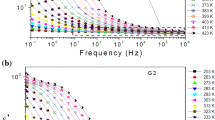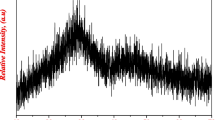Abstract
Use of the Maxwell equation for the conductivity of dielectrics and the theory of mechanical losses in glasses caused by ionic shifts has made it possible to calculate directly the temperature of the “ionic” maximum of mechanical losses using data on direct current conductivity. The Maxwell equation was used without changes, in the view accepted in electromagnetic theory. An intuitive physicochemical interpretation of the nature of ionic conductivity measured at constant voltage as a relaxation process was suggested. Verification of the suggestion equation’s validity was performed for one-alkali glasses in silicate, borosilicate, phosphate, borate, and germanate systems. The ratio of calculated and experimental values of the temperature of the “ionic” internal-friction maximum corresponds to 0.995 ± 0.034 and does not depend on the frequency of measurements of internal friction (it changed by four orders) or the parameters characterizing conductivity. These results also confirm the validity of the Maxwell equation for the conductivity of dielectrics. The possibility of describing the direct current ionic conductivity of glasses as a Debye relaxation transition proved in this work is a consequence of the constant voltage condition. The design of a theory for the condition of natural decay of a given potential, when the Kohlrausch relaxation regularity becomes valid, represents a principally important problem of physics and physical chemistry of disordered systems.
Similar content being viewed by others
References
Nemilov, S.V., Thermodynamic and Kinetic Aspects of the Vitreous State, Boca Raton, Florida, United States: CRC Press, 1995.
Greaves, G.N. and Sen, S., Inorganic Glasses, Glass-Forming Liquids, and Amorphous Solids, Adv. Phys., 2007, vol. 56, no. 1, pp. 1–166.
Nemilov, S.V., Structural Relaxation in Oxide Glasses at Room Temperature, Phys. Chem. Glasses, 2007, vol. 48, no. 4, pp. 291–295.
Nemilov, S.V., Relaxation Processes in Inorganic Melts and Glasses: An Elastic Continuum Model as a Promising Basis for the Description of the Viscosity and Electrical Conductivity, Glass Phys. Chem., 2010, vol. 36, no. 3, pp. 253–285.
Nemilov, S.V., Structural Aspect of Possible Interrelation between Fragility (Length) of Glass-Forming Melts and Poisson’s Ratio of Glasses, J. Non-Cryst. Solids, 2007, vol. 353, nos. 52–54, pp. 4613–4632.
Nemilov, S.V., The Review of Possible Interrelations between Ionic Conductivity, Internal Friction, and the Viscosity of Glasses and Glass-Forming Melts within the Framework of Maxwell Equations, J. Non-Cryst. Solids, 2011, vol. 357, no. 4, pp. 1243–1263.
Nemilov, S.V., Interrelation between the Shear Modulus and the Molecular Parameters of Viscous Flow for Glass-Forming Liquids, J. Non-Cryst. Solids, 2006, vol. 352, nos. 26–27, pp. 2715–2725.
Maxwell, J.C., A Treatise on Electricity and Magnetism, Oxford: Clarendon, 1891, 3rd ed., vol. 1.
Maxwell, J.C., A Treatise on Electricity and Magnetism, Oxford: Clarendon, 1891. Translated under the title Traktat ob elektrichestve i magnetizme, Moscow: Nauka, 1989, vol. 1.
Stratton, J.A., Electromagnetic Theory, New York: McGraw-Hill, 1941.
Maxwell, J.C., On the Dynamical Theory of Gases, Philos. Trans., 1867, vol. 157, pp. 49–88.
Becker, R., Theorie der Elektrizität: Band I. Einführung in die Maxwellsche Theorie der Elektrizität, Leipzig: Elfte Auflage, 1941.
Feynman, R., Leighton, R., and Sands, M, The Feynman Lectures on Physics: Volume 2: Mainly Electromagnetism and Matter, Reading: Addison-Wesley, 1964. Translated under the title Feinmanovskie lektsii po fizike: Vypusk 6. Elektrodinamika, Moscow: Editorial URSS, 2004.
Frenkel’, Ya.I., Elektrodinamika (Obshchaya teoriya), Sobranie izbrannykh trudov (Electrodynamics (The General Theory of Electricity): A Collection of Selected Works), Moscow: Academy of Sciences of the Soviet Union, 1956, vol. 1 [in Russian].
Landau, L.D. and Lifshitz, E.M., Elektrodinamika sploshnykh sred. Tom 8. Teoreticheskaya fizika, Moscow: Nauka, 1992. Translated under the title Course of Theoretical Physics: Volume 8. Electrodynamics of Continuous Media, Oxford: Butterworth-Heinemann, 1993.
Moynihan, C.T., Balitactac, N., Boone, L., and Litovitz, T.A., Comparison of Shear and Conductivity Relaxation Times for Concentrated Lithium Chloride Solutions, J. Chem. Phys., 1971, vol. 55, no. 6, pp. 3013–3019.
Angell, C.A., Mobile Ions in Amorphous Solids, Annu. Rev. Phys. Chem., 1992, vol. 43, pp. 693–718.
Vedishcheva, N.M., Shakhmatkin, B.A., and Wright, A.C., The Structure-Property Relationship in Oxide Glasses: A Thermodynamic Approach, Adv. Mater. Res., 2008, vols. 39–40, no. 1, pp. 103–110.
Myuller, R.L., Electrical Conductivity of Solid Ion-Atom Valence Compounds. II: Experimental and Theoretical Expressions for the Molar Conductivity of Borosilicate, Zh. Tekh. Fiz., 1955, vol. 25, no. 2, pp. 246–255.
Skanavi, G.I., Fizika dielektrikov (Oblast’ slabykh polei) (The Physics of Dielectrics: The Region of Weak Fields), Moscow: Gostekhteorizdat, 1949 [in Russian].
Mazurin, O.V., Glass in a Direct Electric Field, in The Structure of Glass: Volume 4. Electrical Properties and Structure of Glass, Mazurin, O.V., Ed., New York: Consultant Bureau, 1965, pp. 5–55.
Glasstone, S., Laidler, K., and Eyring, H., The Theory of Rate Processes, New York: McGraw-Hill, 1941.
Nemilov, S.V., Kinetics of Elementary Processes in the Condensed State: I. Relationship of the Statistical and Quantum Models of Electrical Conduction with the Kinetic Dushman Equation, Zh. Fiz. Khim., 1967, vol. 41, no. 8, pp. 1934–1941.
Nemilov, S.V., On the Relationship between the Statistical and Quantum Models of Electrical Conduction in Solids, in Stekloobraznoe sostoyanie. Elektricheskie svoistva stekla. Trudy Vsesoyuznogo simpoziuma (Proceedings of the All-Union Symposium on the Vitreous state: Electrical Properties of Glass), Yerevan: AN ArmSSR, 1969, vol. 5,issue 1, pp. 61–68.
Nemilov, S.V., Entropy of Activation and the Nature of Ionic and Atomic Displacements in the Glass, Tr. Gos. Opt. Inst., 1972, vol. 39, no. 170, pp. 107–124.
Polanyi, M. and Wigner, E., Uber die Interferenz von Eigenschwingungen als Ursache von Energieschwankungen und chemischer Umsetzungen, Z. Phys. Chem., Abt. A, 1928, vol. 139, pp. 439–452.
Hanggi, P., Talkner, P., and Borkovec, M., Reaction-Rate Theory: Fifty Years after Kramers, Rev. Mod. Phys., 1990, vol. 62, no. 2, pp. 251–341.
Nemilov, S.V., Theoretical and Experimental Justification of the Method for Measurement of the Viscosity of Glasses on the Basis of the Indentation of Solid Indenters into a Plate, Fiz. Khim. Stekla, 1977, vol. 3, no. 2, pp. 148–157.
Zdaniewsky, W.A., Rindone, G.E., and Day, D.E., The Internal Friction of Glasses, J. Mater. Sci., 1979, vol. 14, pp. 763–775.
Shelby, J.E. and Day, D.E., Mechanical Relaxation in Mixed-Alkali Silicate Glasses: Results, J. Am. Ceram. Soc., 1969, vol. 52, no. 4, pp. 169–177.
Roling, B. and Ingram, M.D., Analysis of Mechanical Losses Due to Ion-Transport Processes in Silicate Glasses, Phys. Rev. B: Condens. Matter, 1998, vol. 57, no. 22, pp. 14192–14199.
Postnikov, V.S., Fizika i khimiya tverdogo sostoyaniya (The Physics and Chemistry of the Solid State), Moscow: Metallurgiya, 1978 [in Russian].
Knödler, D., Stiller, O., and Dietrich, W., Dynamic Structure Factor and Acoustic Attenuation in Disordered Solid Electrolytes, Philos. Mag. B, 1995, vol. 71, no. 4, pp. 661–667.
Roling, B., Happe, A., Ingram, M.D., and Funke, K., Interrelation between Different Mixed Cation Effects in the Electrical Conductivity and Mechanical Loss Spectra of Ion Conducting Glasses, J. Phys. Chem. B, 1999, vol. 103, no. 20, pp. 4122–4127.
Khar’yuzov, V.A. and Zorin, A.P., On the Calculation of the Dielectric Permittivity of Glass Composition, in Elektronnaya tekhnika. Seriya 14. Materialy (Neorganicheskie dielektriki) (Electronic Engineering: Series 14. Materials (Inorganic Dielectrics)), 1967, no. 3, pp. 65–69.
Mazurin, O.V., Electrical Properties of Glasses, in Steklo. Spravochnik (A Reference Book on Glasses), Pavlushkin, N.M., Ed., Moscow: Stroiizdat, 1973, pp. 46–59 [in Russian].
SciGlass-7.0: Database, Shrewsbury, Massachusetts, United States: Institute of Theoretical Chemistry, 2005.
Roling, B. and Ingram, M.D., Mixed Alkaline-Earth Effect in Ionic Conducting Glasses, J. Non-Cryst. Solids, 2000, vol. 265, nos. 1–2, pp. 113–119.
Dyre, J.C., Maass, P., Roling, B., and Sidebottom, D.L., Fundamental Questions Relating to Ion Conduction in Disordered Solids, Rep. Prog. Phys., 2009, vol. 72, no. 1, pp. 1–15.
Rötger, H., Neuere Erkenntnisse über das Relaxationsverhalten der Glaser, Silikattechnik, 1959, vol. 10, no. 2, pp. 57–62.
De Waal, H., Internal Friction of Sodium Disilicate Glass after Ion Exchange, Phys. Chem. Glasses, 1969, vol. 10, no. 3, pp. 108–116.
Sokolov, I.A., Tarlakov, Yu.P., Ustinov, N.Yu., Valova, N.A., and Pronkin, A.A., Influence of the Nature of an Alkali Cation on the Electrical Conductivity of Vitreous MePO3 (Me = Li, Na, or K), Glass Phys. Chem., 2003, vol. 29, no. 3, pp. 305–309.
Ngai, K.L., A Review of Critical Experimental Facts in Electrical Relaxation and Ionic Diffusion in Ionically Conducting Glasses and Melts, J. Non-Cryst. Solids, 1996, vol. 203, pp. 232–245.
Volchek, A.O., Gusarov, A.I., and Dotsenko, A.V., Mechanisms of Nonexponential Relaxation in the Glass Transition Region, Glass Phys. Chem., 1996, vol. 22, no. 4, pp. 301–306.
Silescu, H., Heterogeneity at the Glass Transition: AReview, J. Non-Cryst. Solids, 1999, vol. 243, nos. 2–3, pp. 81–108.
Williams, G., Molecular Motion in Glass-Forming Liquids, J. Non-Cryst. Solids, 1991, vol. 131–132, pp. 1–12.
Nemilov, S.V., Physical Ageing of Silicate Glasses, Glass Sci. Technol., 2003, vol. 76, no. 1, pp. 33–42.
Ngai, K.L., Universality of Low-Frequency Fluctuation, Dissipation, and Relaxation Properties of Condensed Matter: Part 1, Commun. Solid State Phys., 1979, vol. 9, no. 4, pp. 127–140.
Ngai, K.L., Universality of Low-Frequency Fluctuation, Dissipation, and Relaxation Properties of Condensed Matter: Part 2, Commun. Solid State Phys., 1979, vol. 9, no. 5, pp. 141–155.
Ngai, K.L., Rajagopal, A.K., and Teitler, S., Slowing Down of Relaxation in a Complex System by Constrained Dynamics, J. Chem. Phys., 1988, vol. 88, no. 8, pp. 5086–5094.
Palmer, R.G., Stein, D.L., Abrahams, E., and Anderson, P.W., Models of Hierarchically Constrained Dynamics for Glassy Relaxation, Phys. Rev. Lett., 1984, vol. 53, no. 10, pp. 958–961.
Van Kampen, N.G., Stochastic Processes in Physics and Chemistry, Amsterdam: North-Holland, 1995.
Chamberlin, R.A. and Kingsbury, D.W.J., Non-Debye and Non-Arrhenius Primary Response of Liquids, Glasses, Polymers, and Crystals, J. Non-Cryst. Solids, 1994, vols. 172/174, pp. 318–326.
Chamberlin, R.A., Böhmer, R., Sanchez, E., and Angell, C.A., Signature of Ergodicity in the Dynamic Response of Amorphous Systems, Phys. Rev. B: Condens. Matter., 1992, vol. 46, no. 9, pp. 5787–5790.
Chamberlin, R.A., Non-Arrhenius Response of Glass-Forming Liquids, Phys. Rev. B: Condens. Matter, 1993, vol. 48, no. 21, pp. 15638–15643.
Author information
Authors and Affiliations
Corresponding author
Additional information
Original Russian Text © S.V. Nemilov, 2012, published in Fizika i Khimiya Stekla.
Rights and permissions
About this article
Cite this article
Nemilov, S.V. Maxwell equation for conductivity of dielectrics as the basis of direct relationship of ionic electrical conductivity and mechanical losses in glasses. New problems of physical chemistry of glass. Glass Phys Chem 38, 27–40 (2012). https://doi.org/10.1134/S1087659612010105
Received:
Published:
Issue Date:
DOI: https://doi.org/10.1134/S1087659612010105




